Neighbours across the sea: A brief history of Anglo-Irish relations
- Published
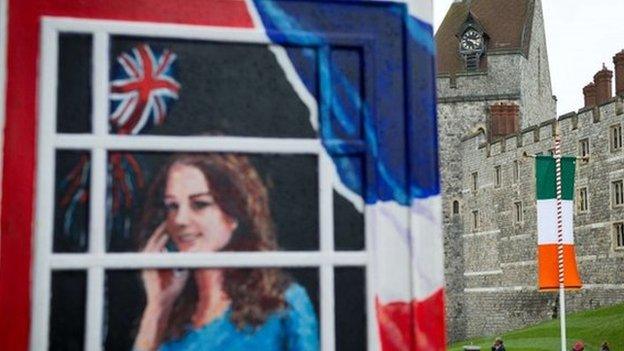
Celebrating the two countries' bonds will be the main theme of the Irish president's four-day visit
Irish president Michael D Higgins' four-day state visit to the UK, the first for an Irish head of state, is another milestone in Anglo-Irish relations.
Over the years and centuries, it is a relationship that has been marked by insurrection, war and strained diplomacy despite geographical proximity and many cultural and familial ties.

Early days of English rule
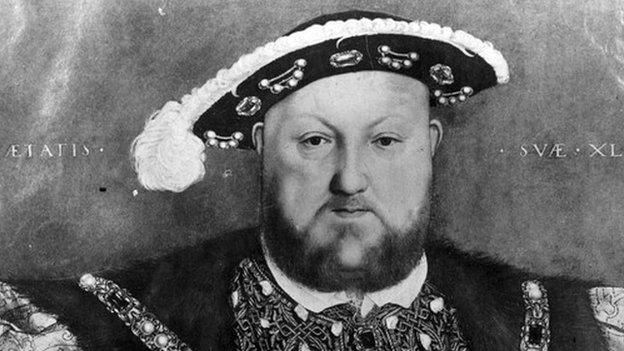
Henry VIII was the first English monarch to also be King of Ireland
The Norman invasion of Ireland in the late 12th Century marked the beginning of 700 years of shared history between neighbouring islands separated, at their furthest, by about 150 miles.
The English Crown did not assert full control of Ireland until 1541, when the Irish Parliament bestowed the title of King of Ireland on Henry VIII after an uprising by the Earl of Kildare threatened regal hegemony.
The arrival of thousands of Protestant settlers from England and Scotland displaced many of the existing Catholic landholders and sowed the seeds for centuries of on-off sectarian and military conflict.
Wars in the middle and end of the 17th Century cemented the Protestant ascendancy, with William of Orange's victory over James II in the Battle of Boyne in 1690 both celebrated and mourned to this day.
The Irish Parliament was abolished in 1801, with Ireland becoming a part of the new United Kingdom of Great Britain and Ireland under the Act of Union.
The Great Potato Famine of the 1840s, in which a million people are estimated to have died and led a further two million to emigrate, is regarded by many as a turning point in relations between the countries.

The birth of a nation
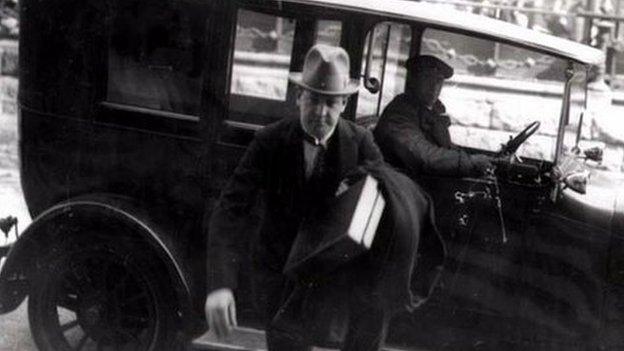
Michael Collins is regarded as one of the architects of modern Ireland
The second half of the 19th Century was marked by the rise of competing nationalist movements and battles over home rule which decided the fate of British prime ministers.
Those seeking a constitutional route to self-government were rewarded with the restoration of home rule in 1914 - although this was soon suspended at the outbreak of World War I.
More than 200,000 Irish men fought for their King and country in the conflict, almost a quarter never to return.
It was against this turbulent backdrop that those who believed that armed struggle was the only way to achieve their ultimate goal of independence for Ireland asserted themselves.
The Easter Rising of 24 April 1916, which was brutally dealt with by the authorities after hopes of German assistance did not materialise, remains to this day the most symbolic manifestation of this fight.
The 1919-21 Anglo-Irish War which followed saw numerous atrocities on both sides, by a nascent Irish Republican Army (IRA), whose leaders included Michael Collins, and a British government whose authority was waning.
The agreement which eventually led to the 1922 partition of Ireland and the creation of the Irish Free State, remained a source of division for 70 years.
Michael Collins only outlived the signing of the Anglo-Irish Treaty by nine months, gunned down during the civil war that ensued, while David Lloyd George quit as prime minister a few month later.

The troubles
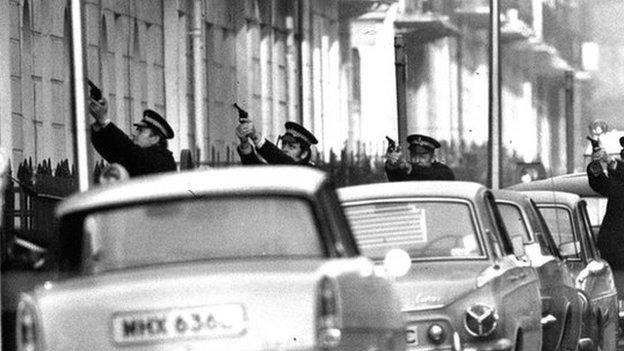
Attacks on Britain became a familiar feature of the 1970s and 1980s
The "No Blacks, No Irish, No Dogs" signs displayed in boarding houses in British cities in the 1950s and 1960s seem part of a distant era now but were a virulent symbol of the distrust between the two countries.
While sectarian tensions were not new in Northern Ireland and IRA attacks on parts of Britain dated back to 1939, the 30-year conflict known as the troubles was of a different magnitude altogether.
Events such as Bloody Sunday, the hunger strikes, the bombing of the Conservative Party conference at Brighton and the Omagh bombing are seared on the consciousness of a generation, whatever their political and sectarian loyalties.
The root causes of the conflict will continue to be pored over, but the true toll in terms of human suffering may never be known.
It is estimated that more than 3,600 people were killed during the violence between 1969 and 1998.
The vast majority of deaths were in Northern Ireland, but more than 100 people are estimated to have been killed in other parts of the UK and also in the Irish Republic.

Political reconciliation
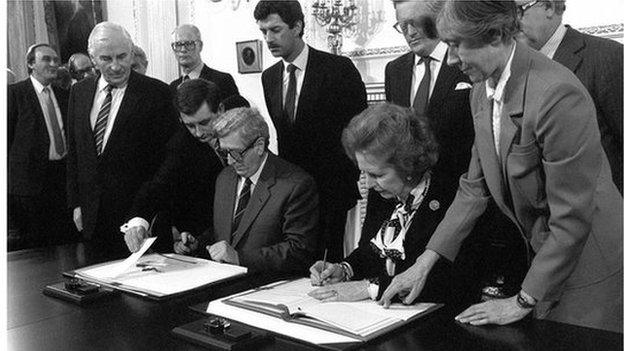
Relations between Dublin and London were often strained despite formal agreements
After decades of strife, the 1985 Anglo-Irish Agreement was a ground-breaking moment, as much for its symbolism as for its actual impact.
Signed by British Prime Minister Margaret Thatcher and her Irish counterpart Garret FitzGerald, it paved the way for regular conferences between British and Irish ministers on matters affecting Northern Ireland.
This gave Dublin a role in Northern Ireland for the first time in more than 60 years.
The fruits of this closer co-operation, although resisted by some at time, were felt later as international support for the peace process in Northern Ireland gathered pace after the 1994 IRA ceasefire.
The 1998 Good Friday Agreement, which reaffirmed Northern Ireland's constitutional status in the UK while also repealing the law by which Ireland was partitioned, was approved by 94% of Irish voters in a referendum.

The Crown and Ireland

The Queen's visit to Ireland in 2011 was well received
Before her successful state visit in 2011, Ireland was one of the few countries that the Queen had never visited in an official capacity.
This was evidence of the legacy of historical recrimination and mutual suspicion which until recently existed between the two countries.
Despite becoming a self-governing dominion in 1922, the Irish Free State remained a member of the British Empire, with the British sovereign remaining as head of state.
Ireland became a fully independent state in 1937 but did not withdraw from the Commonwealth until 12 years later. The prospect of rejoining has never been seriously pursued.
However, the Queen's 2011 visit - in which she paid her respects to republican dead and gave a speech on Anglo-Irish history - drew near universal praise and the prospect of members of the Royal Family attending events for the centenary of the Easter Rising is being entertained.

Sporting and cultural bonds

Ireland's recent victory in the Six Nations was emblematic of the sporting rivalry between the two nations
The long sporting rivalry between Ireland and the UK's "home nations" has often transcended politics but it has, at times, also encapsulated historic shifts in attitudes.
When God Save The Queen was played at Croke Park - the scene of an infamous police massacre of civilians during the Anglo-Irish War - before a rugby match in 2007, the absence of any booing was seen as a pivotal moment in the long process of reconciliation.
Whether it is the shared passion among fans for the Six Nations or the Cheltenham Festival, Anglo-Irish battles are now fought out on very different turf indeed.
Patterns of emigration have ebbed and flowed over the years but more than 400,000 Irish citizens call London home and there are large, vibrant Irish communities in most of England and Scotland's largest cities.
The great Irish writers of the 20th Century, such as Samuel Beckett and James Joyce, preferred Paris to London, but the lure of London as a literary destination has grown in recent decades.
Michael Gambon, Pierce Brosnan, Graham Norton and Terry Wogan, are among the many members of the Irish Diaspora who have become pillars of the theatrical and showbusiness establishment.
Ireland leads the UK by seven victories to five in the Eurovision song contest.

Trading places
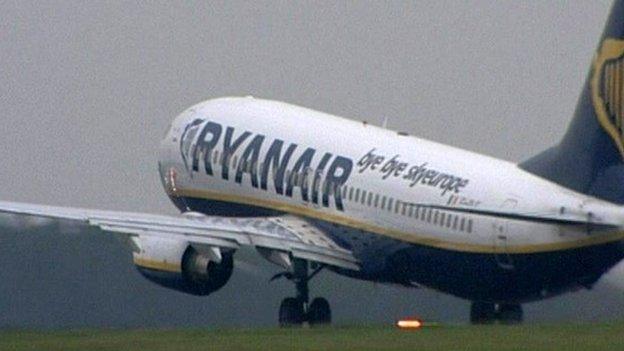
Ryanair is one of the many businesses based in both Britain and Ireland
Financially, the UK and the Irish Republic are now intertwined as never before.
The Irish Republic is the UK's fifth largest trading partner, while nearly one in five exports leaving Irish shores is destined for the UK. In total, bilateral trade between the two is close to £30bn.
There are 50 Irish businesses listed on the London Stock Exchange, including packaging giant Smurfit Kappa, food ingredients maker Kerry Group and bookmakers Paddy Power, while one of Ireland's most famous exports, Guinness, is owned by British drinks firm Diageo.
The way in which the two economies are emerging from the recession caused by the 2008 banking crash at a similar rate points to the similarities and mutual interests between them.
It was telling, at the height of Irish economic woes in 2010, that the UK Parliament approved a multi-billion loan to Dublin with few if any dissenting voices at a time when "EU bailout" was something of a dirty word.
- Published6 April 2014
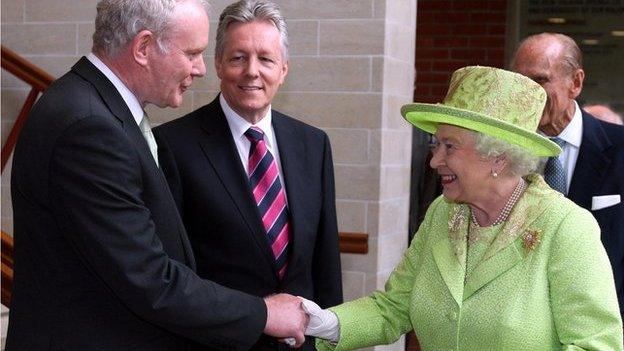
- Published6 April 2014
.jpg)